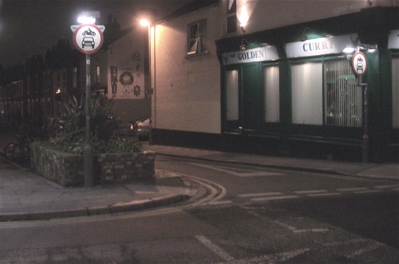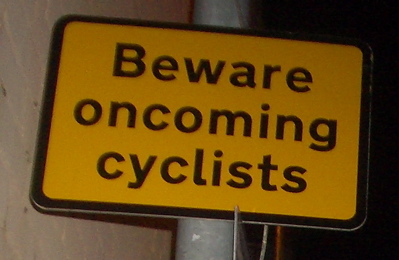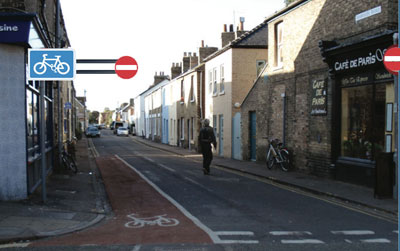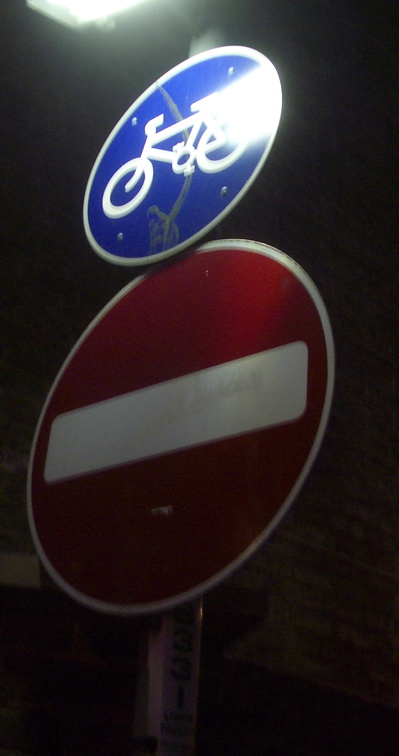
On the 18th of December 2008, 7.30pm at St. Barnabas Church, Mill Road, there is to be a public meeting about “contraflow cycling” on some of the streets off Mill Road. Contraflow cycling is where cyclists are allowed to travel in both directions on roads which are one-way only for motorised vehicles.
The streets currently under consideration according to the City Council’s consultation leaflet which contains the County Council’s plans are:
- Mackenzie Road
- Covent Garden
- Mawson Road
- Kingston Street
There are two questions which I think can be addressed separately.
- Should cycling against the flow of motor traffic on these one way streets be permitted?
- Where cycling against the flow of motor traffic on one way streets is permitted, how should the fact it is allowed be indicated? The challenge is making it clear to drivers they can’t go the wrong way up the one way streets, but letting cyclists know they can.
1. Should contraflow cycling on these streets be permitted?
While the meeting is being promoted by the County Council as being about contraflow cycling, no changes are currently being proposed by the County Council to which streets contraflow cycling is permitted on. Labour councillors and activists have however decided to use the consultation on proposed changes to signage, road markings etc. to lobby for a reversal of the policy to allow contraflow cycling on certain streets off Mill Road. Labour have distributed a leaflet stating:
“cyclists contraflow dangerously along streets which are too narrow for proper cycle lanes”.
That comes down to a matter of judgement and I disagree with their suggestion that contraflow cycling in these streets is unduly dangerous. I think Kingston Street and Mackenzie Road in particular are wide enough for a car to safely pass an oncoming bike, even with the presence of parked cars. That said I think there is room to make all the streets under consideration even safer and more cycle friendly, there will be funding for improvements in the area arising from the station area redevelopment. Last time I heard a figure: £250 000 had been allocated to manage traffic on Tenison Road to stop rat running as well as mitigate the impact from students. Hopefully when the relevant agreement is negotiated by councillors that can be increased and applied to the broader area which will be directly impacted by the development.
The approved plans for the station area redevelopment include one thousand two hundred and fifty units of student accommodation for Anglia Ruskin University (ARU). Many students will cycle from their accommodation to the ARU East Road site down Tenison Road, Mill Road and Mackenzie Road. The county council’s transport assessment of the CB1 development (see p. 42 of the linked document) describes this route as the “strong desire line of the students” Students going from their accommodation to university will be travelling against the one-way motorised traffic on Mackenzie Road. Even if the Labour councillors did succeed in getting the no-entry signs they want reinstated on Mackenzie Road and banning contraflow cycling I think it would be a futile gesture setting up an impossible (and pointless) to enforce situation for the future. Hundreds of students, many visitors from foreign countries, would be criminalised if they took a direct route between where they lived and where they studied.
Contraflow cycling encourages people to use their bikes as it makes trips easier and quicker. There are many examples around the city where this works very well and shortens cyclists’ journeys. While I support the general principle of contraflow cycling, I accept there are places where the roads, with parked cars, are too narrow and I would not support it, the Mill Road ends of Ross Street, Thoday Street and Catherine Street for example.
The Cambridge Cycling Campaign’s page on Two-way cycling in one-way streets, lists further reasons for supporting two way cycling. It points to evidence that there is a lack of danger and to Government Guidance (Local Transport Note 1/04) section 4.11.6 of which states:
… it is strongly recommended that existing one-way streets are studied with a view to modifying them to accommodate contraflow cycling where practicable. […] it is important to recognise that if a one-way street is not made available to cyclists in contraflow, they may have to use a more hazardous alternative which will almost certainly be a less direct route.
2. Where cycling against the flow of motor traffic on one way streets is permitted, how should the fact it is allowed be indicated?

Here I agree with the Labour councillors who have said:
“Signage which motorists can understand is not available or legal, so they drive the wrong way down contra-flow streets”.
A 2007 survey by car maker Vauxhall revealed one-third of British motorists could not identify the sign for “no motor vehicles”. It is this sign which is currently used on the streets off Mill Road to indicate that cyclists, but not motor vehicles, can turn off Mill Road onto Mackenzie Road, Mawson Road and Kingston Street. Not only might drivers go through the signs, but cyclists may not realise the streets are open to them.
The problem we have is the law (S.36 of the The Road Traffic Act 1988), which says it is an offence for anyone to go though a properly sited no-entry sign. In many places cyclists are able to pass to the right or left of a pair of no entry signs via a “cycle slip”. There are problems with this approach:
- Cycle slips are expensive to install
- Cycle slips can be unused as they are not on cyclists’ desire line, and due to lack of traffic they sometimes end up full of leaves and other debris making them hazardous
- Cycle slips require a road to be wide enough for them to be installed
The Cambridge Cycling Campaign have a gallery containing examples from Cambridge and around the world showing solutions to the problem of signing “No Entry – except cyclists”.
Direction 20(2) – of the Traffic Signs Regulations and General Directions 2002 is the relevant law, it states:
A plate shown in diagram 954.3 [The “Except Buses and Cycles” plate] or 954.4 [The “Except Cycles” plate] or the sign shown in diagram 954.6 [The “Except buses & cycles” plate, small round version for use with traffic lights] or 954.7 [The “Except buses, taxis & cycles” plate, small round version for use with traffic lights] shall not be placed in combination with the sign shown in diagram 616 [The “No Entry” sign].
Clearly this needs to be amended, or a direction added allowing it to be ignored where required.
Note it is permissible to have an “Except Buses” plate along with a no entry sign.
Considering other options:
- The small round blue cycle sign, means “route for use by pedal cycles only”, and the sign can only be used on roads where there is an order (or similar) which prohibits or restricts the use of the road by traffic, so we can’t legally place one of those under the no-entry sign. (Or is a street being one-way restriction enough?)
- It is an offence to pass a no-entry sign, so placing a cycle route directional sign next to it encouraging cyclists to go through would not be sensible, it would be a sign encouraging people to break the law.
Cambridge’s MP David Howarth asked a written Parliamentary question asking why Cambridgeshire County Council could not be allowed install “No Entry Except for Cyclists” signage. He asked this question in 2005, and the problem has not been solved. County Cllr Nichola Harrison asked again in September 2008 being told such signs would be “confusing for drivers and cyclists”.
I support standardisation of our signage throughout the UK. Driving between the cities and towns which make up Los Angeles, where all sorts of road markings suddenly change at the borders made me appreciate the consistency we have here; though driving though different London boroughs can be a subtler but similar experience. Having said that not allowing the no entry except cycles sign, in circumstances where its use cannot be avoided, is barmy. Perhaps the City and County Council should ignore the law; sometimes change has to come from the bottom up, perhaps Cambridge should lead the nation on cycle signage in this area. This is a dangerous slippery slope though, I would prefer to see David Howarth make another effort to get this clearly obviously required change in the law made.
Final comments
So in summary, I support contraflow cycling in general, and think the particular streets in question are suitable for contraflow cycling. There is a clear signage problem, and I would like to see the law changed to enable the use of more easily understood signs. I would prefer a much cheaper and simpler “No Entry Except Cycles” sign at Mackenzie Road rather than the proposed cycle slip. There is no need for two traffic lanes on Mackenzie road by the Mill Road junction, one could be removed giving space for a marked cycle lane. Again at Kingston Street, the I would prefer to see a “No Entry Except Cycles” rather than the no motor vehicles sign. I think a red cycle way, painted cycle symbol, and cycling directional signs ought be placed at both junctions. No left/right turn signs, with “except cyclists” plates, could be used to make the restrictions clearer.
I am ambivalent about the use of double yellow lines on mandatory cycle lanes. I feel they ought not be necessary. We need to make sure that the police and traffic wardens have, and are using the appropriate powers to enforce the law which forbids parking in mandatory cycle lanes. We need consistency across the city, if these cycle lanes on Covent Garden and Mawson street get double yellow lines, why not others?
I believe it would be logical to extend the contraflow cycling permitted in this area to include Collier Road, Emery Street and Perowne Street, and think this ought be accompanied by only minimal signage and no highways works (this is much less important than the other streets mentioned due to the lower traffic volume, but consistency in approach is required especially as enforcement of cycling the wrong way down one way streets is carried out in the City.)
Cambridge City Council are currently running an online consultation on two way cycling on these roads.
(The “Beware oncomming cyclists” sign is on Kingston Street, Cambridge, and the photograph at the top of the article is the Kingston Street / Mill Road junction)
4 responses to “Two Way Cycling on One Way Streets”
I know the blue sign is slightly wrong, but …

(It would be simpler to change the law, this would just get in the way, and it would look even worse in real life than in my mock-up)
Apparently in some places clear but non compliant signs are used on public roads in the city.
Malcolm Street:

Upon reading above article, I decided to sketch out an idea for a cheap and easy cycle plug replacement whatnot. The result would be here and feedback would be (rather) useful.
The Cambridge Cycling Campaign let me know they’re going to be changing their leaflet which I quoted in the article. I’ve updated it to use the new link.